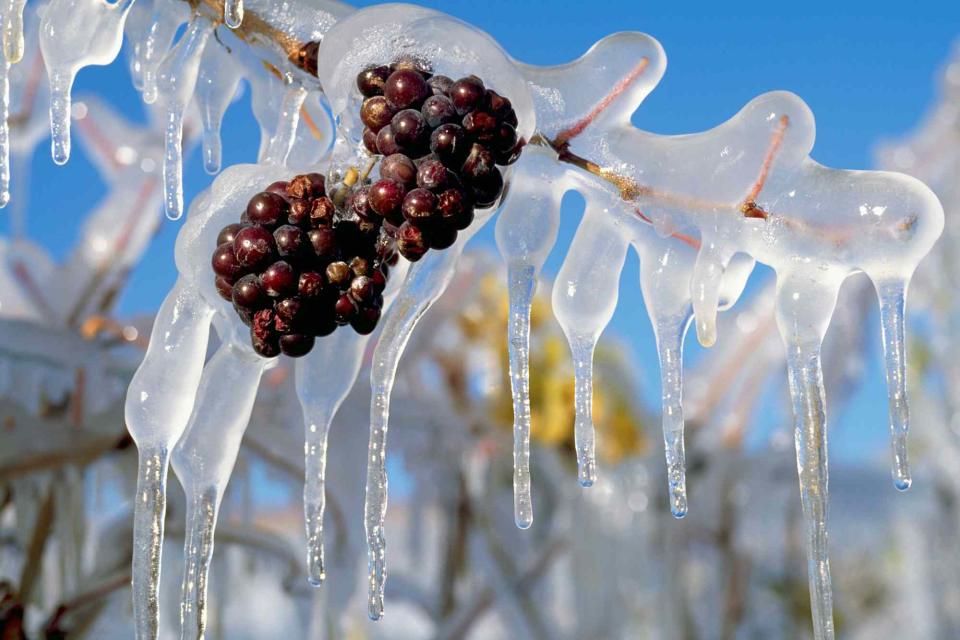Ice Wine Is the Nightcap You're Missing Out On
This misunderstood sweet wine is hard to produce and profoundly delicious.

Gunter Marx / Getty Images
Sweet wines are often generalized, but the fact remains that there really is no single style that embodies them all. From the great botrytized wines of Sauternes to powerful fortified wines like port, there are far more ways of producing sweet wines than most people give them credit for.
Among the most misunderstood are ice wines. This is unfortunate, because they have the potential to be profoundly delicious. Ice wines are produced around the world, but they reach their highest level of quality and notoriety in three places: Canada, particularly Ontario in the east and British Columbia in the west; upstate New York; and Germany. They can be found elsewhere, but these three places generate the lion’s share of ice wine buzz.
Whether it’s the Okanagan Valley of British Columbia, Niagara in Ontario, New York’s Finger Lakes, or Rheinhessen, Rheingau, Pfalz, or other German wine regions, the production of ice wine all comes down to the weather. Whereas dry wines are produced by harvesting grapes in the autumn, when they’ve achieved optimal ripeness — a balance between acid and sugar, and for reds, the kind of ripe tannins that will structure a wine without making it seem astringent — ice wines are left on the vine past the usual harvesting window in an attempt to allow the mercury to dip low enough that the individual grapes begin to freeze.
Once this happens, the grapes are harvested — usually at night, in order to ensure that they remain cold and don’t begin to thaw in the warmth of the morning or daytime sun — and are gently pressed soon after. If it’s done right, the liquid that’s squeezed from the grapes has a higher ratio of sugar, since a significant proportion of the water in the berries is left behind as ice crystals. Ice wines, then, are naturally sweet — no sugar has to be added, it’s just that the balance of sugar and water has been shifted as a result of the extended ripening period on the vine and the temperatures at which harvesting and pressing occurs.
There are risks, however: For all wines — white, red, dry, and sweet — the longer the grapes are left unharvested, the greater the risks of adverse weather or climate events affecting them. But the chances that growers and producers take with grapes intended for ice wine are worth it: The wines are ambrosial, with an unctuousness in texture and a deep core of sweetness that is the perfect way to end a meal. They also pair well with salty and savory dishes like foie gras; cheeses like Gruyere and certain blues; fruit; chocolate; aromatic and moderately spicy dishes; and more.
Depending on where they’re made, ice wines are generally produced from white grapes like Vidal Blanc, Riesling, Chenin Blanc, and Gewürztraminer, or even red grapes like Cabernet Franc. The best of them maintain a sense of acidity alongside their inherent sweetness, which allows them to stay balanced and pair better with food. As with all sweet wines, examples without enough acidity may come off as cloying, lacking in nuance, and inelegant. They also are more difficult to pair with food, as their sweetness runs the risk of overwhelming the flavors of the dish. However, appropriately bright ones are very versatile and almost dangerously easy to drink.
During the holiday season, ice wine has the potential to play a key part both during dinners and after. But really, they should be enjoyed throughout the year: Alongside a summertime fruit salad — maybe even splashed into it as well, which is delicious — it’s just as appealing. No matter when you open up a bottle, a great ice wine provides immense pleasure and food-friendliness.

